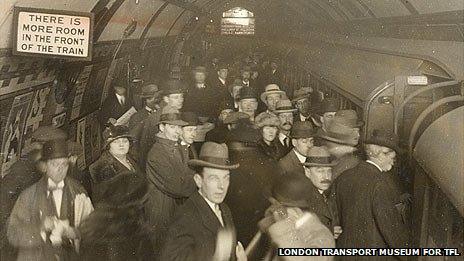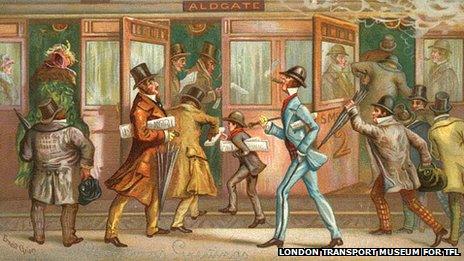‘Sulphurous’ fumes and class division on Victorian Tube
- Published

Overcrowding was a big issue by 1915 but it was a recurring concern since 1877
At first families feared they would be poisoned by the "sulphurous exhalations" that spewed from below.
Some imagined the tunnels would collapse under the weight of traffic and houses above.
One newspaper thought the prospect of travelling underground was so horrid it suggested criminals should be "condemned to round trips".
But it did not take long for London's masses to take the Tube to their hearts, won over by the speed of travel across the capital and freedom from the chaos of the city's increasingly crowded streets.
The world's first underground railway was opened to the public 150 years ago out of a necessity to keep the city moving.
Roads were a chaotic mix of horse-drawn carriages and cabs jostling for space with pedestrians, and London's population had jumped from one million in 1800 to 2.5m by 1851.
With no space above the ground, the solution was to dig deep.
'Fears of the dark'
Sam Mullins, London Transport Museum's director, said: "It was a conventional Victorian railway just placed underground.
"An underground railway had excited all sorts of fears of the dark and of being underground."
Railway tunnels were nothing new but this was the first time that all stations between Paddington and Farringdon were below the surface.
While researching the Tube's history, the museum reported the differing opinions about the project in a newly-published book, called Underground: How the Tube Shaped London, to mark the anniversary.
In it, residents are seen complaining during the construction, with one describing it as a "monstrous tyranny and oppression".
But, the mood had changed by 1862, with the Illustrated London News likening the tunnels to "a well-kept street at night".
'Lower than graveyards'
On the eve of the public launch, a special train carrying 500 VIPs made the three-and-a-half-mile journey.
It took them two-and-a-half hours instead of 18 minutes as they stopped at every station, Mr Mullins said.
The next day, 10 January 1863, curious spectators joined thousands of passengers.
Mr Mullins said: "There was a huge sense of expectation.
"There was something clearly novel and exciting about this new form of travel, and hundreds of people gathered to see this kind of wonder of the age and 40,000 people travelled on day one."
In the book, Sir William Hardman, an early passenger, is quoted saying: "The carriages hold 10 persons, with divided seats, and are lighted by gas: they are also so lofty that a six footer may stand erect with his hat on."
The Daily News enthused: "For the first time in the history of the world men can travel in pleasant carriages, and with considerable comfort, lower down than gas pipes and water pipes... lower down than the graveyards."

See how the Tube map has changed over the years
But on the opening day a porter was taken to hospital suffering from "vitiated atmosphere" and several passengers were helped out of the platforms in an "insensible state", fuelling concerns about smoky trains.
As the initial excitement subsided, complaints about overcrowding and fumes increased, sparking a Parliamentary inquiry into the Tube's atmosphere in 1897.
In the 1890s, the Yorkshire Herald said passengers felt "as if they had been chewing Lucifer matches" and the Pall Mall Gazette suggested "prisoners will be condemned to so many continuous 'round trips' as they are now to so many weeks in jail".
'Lady without bonnet'
A mining engineer wrote to The Times saying he had "almost suffocated" and had to be taken to a nearby chemist who gave him what was called a "Metropolitan Mixture". The chemist claimed he saw about "20 cases a day".
Various steps were taken to improve ventilation and reduce smoke but the issue remained a concern until steam trains went out of service from 1905.
Smokers further contributed to the problem of noxious fumes.
Mr Mullins said: "Public opinion obliged them to supply smoking compartments on the carriages from the 1870s, which I guess made the atmosphere even thicker inside than on the outside."
Other Victorian complaints included overcrowding and annoyance when the class divide was not maintained.
One person complained to the Pall Mall Gazette that a "lady without a bonnet and with an infant in arms in my carriage was not a first-class passenger."

The new underground rail service featured in Christmas cards after 1863
But the Underground was not the preserve of the rich. In the first few weeks, 70% of tickets bought were for third-class carriages. The cheap "workmen's fare" for morning services also proved popular.
In 1890, the City and South London Railway (C&SLR) opened, but with single-class carriages.
The Railway Times observed: "We have scarcely yet been educated up to that condition of social equality when lords and ladies will be content to ride side by side with Billingsgate 'fish fags' and Smithfield butchers".
As Londoners embraced subterranean commuting, the experience made its way into literature, nursery rhymes, plays and greeting cards.
'Interleaved with culture'
In Angus Evan Abbott's The Spawn of Fortune (1896), the train comes "wheezing, rocking, screeching" into Charing Cross station.

In an 1896 story Angus Evan Abbott describes a wheezing train entering Charing Cross station
The dark tunnels were the setting for several murder mysteries including one by John Oxenham about an ex-rail employee turned serial killer. It was "deemed too realistic" prompting a complaint from the District Railway, the museum's experts said.
But the Underground did not feature extensively in mysteries tackled by the famous Victorian detective Sherlock Holmes, who lived opposite the Baker Street station, until the Adventure of the Bruce-Partington Plans in 1908.
By then though, nursery rhymes like London Town in 1883 had made the service an endearing part of London life.
Electric trains came in from 1905 and huge generators installed at depots fascinated Londoners so much the C&SLR opened a ticketed viewing gallery in Stockwell.
The love-hate relationship however, continues to this day, said Mr Mullins.
"London wouldn't be London without the underground," he said.
"It's a lot more than moving people, it's extraordinarily interleaved with the culture of the city and its self-identity."